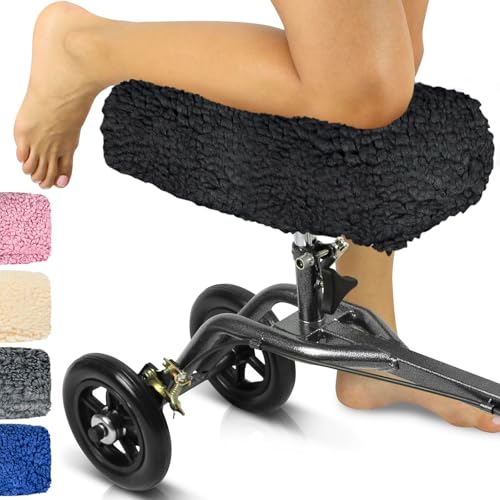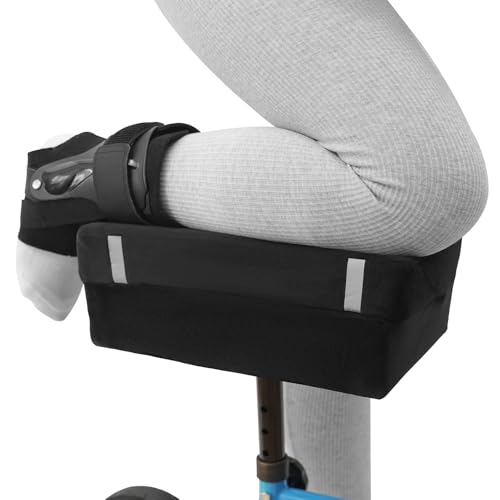Dangers of Knee Scooters:
-
Risk of Falling: Knee scooters have a higher center of gravity compared to crutches, increasing the risk of tipping over, especially on uneven surfaces or when moving too quickly.
-
Limited Stair Accessibility: Knee scooters are not suitable for climbing stairs, making them impractical for individuals who need to navigate multiple levels without an elevator.
-
Inadequate for Certain Injuries: For injuries above the knee, or for those who have both legs affected, knee scooters are not an appropriate choice.
-
Potential for Further Injury: Incorrect usage, such as placing the knee improperly on the pad or using a knee scooter that is not adjusted to the user’s height, can lead to further injuries.
-
Indoor Maneuverability: In tight spaces or crowded areas, maneuvering a knee scooter can be challenging.
When a Knee Scooter May Not Be the Best Option:
-
Multiple Injuries: If you have multiple injuries, including those to the arms or upper body, a knee scooter may not provide adequate support.
-
Long-Distance Travel: For long distances, a wheelchair may be a more practical and comfortable option.
-
Rough Terrain: While all-terrain models are available, traditional knee scooters are not suitable for very rough or uneven surfaces.
-
Limited Physical Capability: Individuals with limited strength or balance issues may find it difficult to operate a knee scooter safely.
-
Financial Constraints: High-quality knee scooters can be expensive, and not all insurance plans cover them, making them less accessible for some individuals.
It’s crucial to consult with a healthcare provider to determine whether a knee scooter is the appropriate mobility aid for your specific condition and needs. Always follow the manufacturer’s guidelines and your healthcare provider’s recommendations to minimize risks.
[/vc_column_text]
Top Knee Scooter Danger Questions Answered
Q: What are the risks of using a knee scooter?
A: The risks of using a knee scooter include the potential for falling due to a higher center of gravity, limited stair accessibility, and the possibility of further injury from incorrect usage or improper adjustment.
Q: Can you use a knee scooter on stairs?
A: No, knee scooters are not designed for climbing stairs. They are impractical for individuals who need to navigate multiple levels without an elevator.
Q: Are knee scooters suitable for all types of injuries?
A: Knee scooters are not suitable for injuries above the knee or for individuals with both legs affected. They are primarily designed for foot and ankle injuries requiring non-weight-bearing support.
Q: Can incorrect usage of a knee scooter lead to further injury?
A: Yes, incorrect usage such as placing the knee improperly on the pad or using a knee scooter not adjusted to the user’s height can lead to further injuries.
Q: How maneuverable are knee scooters in tight spaces?
A: Maneuvering a knee scooter in tight spaces or crowded areas can be challenging, making them less suitable for such environments.
Q: Are knee scooters a good option for long-distance travel?
A: For long distances, a wheelchair may be a more practical and comfortable option compared to a knee scooter.
Q: Are knee scooters suitable for rough terrains?
A: While all-terrain models are available, traditional knee scooters are not suitable for very rough or uneven surfaces.
Q: Who may find it difficult to operate a knee scooter safely?
A: Individuals with limited strength or balance issues may find it difficult to operate a knee scooter safely.
Q: Are knee scooters covered by all insurance plans?
A: Coverage for knee scooters varies by insurance policy. Some may cover the cost partially or fully, while others may not offer coverage. It’s advisable to check with your insurance provider for specific details.
Q: Should you consult a healthcare provider before using a knee scooter?
A: Yes, it’s crucial to consult with a healthcare provider to determine whether a knee scooter is the appropriate mobility aid for your specific condition and needs.
– Content on this site was created by or with the help of the ChatGPT and the OpenAI project.
While knee scooters offer numerous advantages, they are not without their drawbacks and potential dangers. Here are some situations where a knee scooter may not be the best option, along with the associated risks:
Dangers of Knee Scooters:
-
Risk of Falling: Knee scooters have a higher center of gravity compared to crutches, increasing the risk of tipping over, especially on uneven surfaces or when moving too quickly.
-
Limited Stair Accessibility: Knee scooters are not suitable for climbing stairs, making them impractical for individuals who need to navigate multiple levels without an elevator.
-
Inadequate for Certain Injuries: For injuries above the knee, or for those who have both legs affected, knee scooters are not an appropriate choice.
-
Potential for Further Injury: Incorrect usage, such as placing the knee improperly on the pad or using a knee scooter that is not adjusted to the user’s height, can lead to further injuries.
-
Indoor Maneuverability: In tight spaces or crowded areas, maneuvering a knee scooter can be challenging.
When a Knee Scooter May Not Be the Best Option:
-
Multiple Injuries: If you have multiple injuries, including those to the arms or upper body, a knee scooter may not provide adequate support.
-
Long-Distance Travel: For long distances, a wheelchair may be a more practical and comfortable option.
-
Rough Terrain: While all-terrain models are available, traditional knee scooters are not suitable for very rough or uneven surfaces.
-
Limited Physical Capability: Individuals with limited strength or balance issues may find it difficult to operate a knee scooter safely.
-
Financial Constraints: High-quality knee scooters can be expensive, and not all insurance plans cover them, making them less accessible for some individuals.
It’s crucial to consult with a healthcare provider to determine whether a knee scooter is the appropriate mobility aid for your specific condition and needs. Always follow the manufacturer’s guidelines and your healthcare provider’s recommendations to minimize risks.
Top Knee Scooter Danger Questions Answered
Q: What are the risks of using a knee scooter?
A: The risks of using a knee scooter include the potential for falling due to a higher center of gravity, limited stair accessibility, and the possibility of further injury from incorrect usage or improper adjustment.
Q: Can you use a knee scooter on stairs?
A: No, knee scooters are not designed for climbing stairs. They are impractical for individuals who need to navigate multiple levels without an elevator.
Q: Are knee scooters suitable for all types of injuries?
A: Knee scooters are not suitable for injuries above the knee or for individuals with both legs affected. They are primarily designed for foot and ankle injuries requiring non-weight-bearing support.
Q: Can incorrect usage of a knee scooter lead to further injury?
A: Yes, incorrect usage such as placing the knee improperly on the pad or using a knee scooter not adjusted to the user’s height can lead to further injuries.
Q: How maneuverable are knee scooters in tight spaces?
A: Maneuvering a knee scooter in tight spaces or crowded areas can be challenging, making them less suitable for such environments.
Q: Are knee scooters a good option for long-distance travel?
A: For long distances, a wheelchair may be a more practical and comfortable option compared to a knee scooter.
Q: Are knee scooters suitable for rough terrains?
A: While all-terrain models are available, traditional knee scooters are not suitable for very rough or uneven surfaces.
Q: Who may find it difficult to operate a knee scooter safely?
A: Individuals with limited strength or balance issues may find it difficult to operate a knee scooter safely.
Q: Are knee scooters covered by all insurance plans?
A: Coverage for knee scooters varies by insurance policy. Some may cover the cost partially or fully, while others may not offer coverage. It’s advisable to check with your insurance provider for specific details.
Q: Should you consult a healthcare provider before using a knee scooter?
A: Yes, it’s crucial to consult with a healthcare provider to determine whether a knee scooter is the appropriate mobility aid for your specific condition and needs.
– Content on this site was created by or with the help of the ChatGPT and the OpenAI project.







